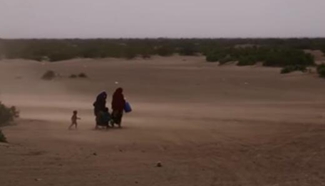SAN FRANCISCO, Feb. 22 (Xinhua) -- States in U.S. Pacific Northwest experience very low snowpack levels in 2014 and 2015, and now researchers suggest that these occurrences could become much more common if average temperatures warm just 2 degrees Celsius.
Based on simulations of previous and predicted snowpack, the study published in the journal The Cryosphere suggests that by mid-century, years like 2015 may happen about once a decade, while snowpack levels similar to 2014 will take place every 4-5 years, as the low snowpack levels were linked to warmer temperatures.
"It is a cautionary tale," said lead author Eric Sproles, who conducted much of the research as a doctoral student at Oregon State University (OSU) and has been working as a hydrologist in Chile. "California received a lot of attention for its drought, but the economic and environmental impacts from those two low-snowpack years were profound in the Pacific Northwest."
The winter of 2014 led to drier springtime conditions and severe drought throughout western Oregon. That pattern was even stronger in 2015. Situation was worse in California, where drought lasted more than four years. However, a fair amount of precipitation, namely 78 percent of normal, still fell in Oregon, but temperatures in the snow zone were 3.3 degrees Celsius warmer than average.
"We set out to learn whether they were just off years, or if they would be likely to happen more often with increased warming. Unfortunately, the data show these will become more commonplace," said Sproles. And the key is what happened in the Cascade Mountains at an elevation of around 4,000 feet, or 1,220 meters, a level that frequently is the boundary between rain and snow.
In 2014, winter precipitation in the mountain region was 96 percent of normal and overall temperatures were 0.7 degrees Celsius warmer than normal. But temperatures in that snow zone were 2.7 degrees Celsius warmer than average.
On March 1 of 2015, 47 percent of the snow monitoring sites in the Willamette River basin registered zero "snow water equivalent" - the amount of water stored in snowpack.
The study focused on the McKenzie River basin, which has a major influence on the Willamette River, all the way to Portland. During summer months, nearly 25 percent of the water in the Willamette at its confluence with the Columbia River originates from the McKenzie. As much as 60 to 80 percent of the volume of the Willamette River in the summer originates from precipitation that fell above 4,000 feet, or or 1,220 meters.
The typically consistent flow of the McKenzie River in the summer of 2015 was at 63 percent of its median flow.
"The study shows how incredibly sensitive the region's snowpack is to increasing temperatures," Sproles was quoted as saying in a news release from OSU.
"The low snow years took place even though precipitation wasn't that bad. But when it falls as rain instead of snow, it loses that ability to function as a natural reservoir in the mountains."
A comparatively cold and wet winter has made many Oregonians forget about the low-snowpack years of 2014 and 2015, Sproles said, but the region has been in a La Niña cycle, which is typically colder and wetter, and is expected to move toward neutral conditions by the end of February.
"It seems like much of the state has been socked with snow and ice this winter," he said, "but despite that, snowpack for the Sandy and Hood River basins is only 110 percent of normal and the Willamette basin snowpack is 124 percent of normal. That is certainly positive, but it seems like those numbers would be a lot higher considering what kind of winter we've had in the valley."












